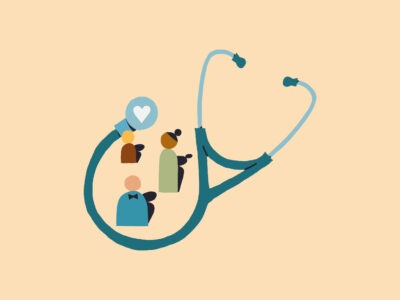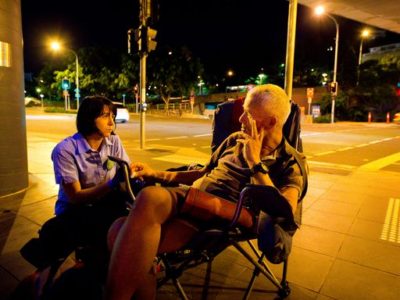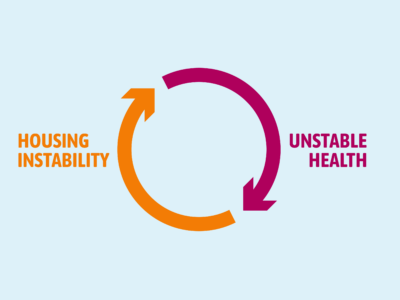In addition to an online survey, Community Solutions conducted conversations with six Built for Zero communities to better understand how public health and homeless response systems are collaborating locally. In this brief, we have summarized themes that emerged across those interviews and survey results.
According to Dr. Sandro Galea, the dean of the Boston University School of Public Health, three criteria must be met for an issue to be considered a public health crisis. The problem must: 1) affect a large number of people, 2) threaten health over the long term, and 3) require large-scale solutions.
Homelessness has proven to meet all three criteria. Despite the fact that homelessness has long been a public health crisis, local public health departments have not traditionally contributed to homeless response systems.
As part of its work to help communities make homelessness rare and brief, Community Solutions has been working to understand the most strategic role for local health departments to play and how they may be most effectively engaged.
As part of this effort, Community Solutions conducted an online survey, and more deeply explored collaborations occurring between public health and homelessness response systems in six communities participating in the organization’s Built for Zero initiative. Conversations were held with homeless response system leaders from San Diego, California; Hartford, Connecticut; Phoenix, Arizona; Fairfax, Virginia; Anchorage, Alaska; and Cook County, Illinois.
This brief summarizes key themes that emerged from those conversations as well as some findings from the online survey.
Key Themes
While there was general alignment of a shared understanding of public health, homelessness was not consistently viewed as being accepted within the scope of public health.
The scope, parameters and definition of “public health” have long been a source of great debate and disagreement. A wide variety of organizations perform vastly different work under the shared umbrella of public health, and there remains no uniform, generally-accepted definition.
The CDC publicly defines public health as “the science of protecting and improving the health of people and their communities.” With additional insights and input, Community Solutions has been operating with the following definition: “Public health can be understood as the art and science of prolonging life at a community and population level through large-scale solutions, preventative measures and data-informed policies.”
Communities did not offer significant recommendations and generally agreed that the definition felt accurate and all-encompassing. However, communities commonly felt that there was a feeling that homelessness was not generally accepted to be within that definition and thus, not within the scope of public health locally.
The online survey results shed some additional light on the scope and limitations of engagements across systems. Respondents shared that common goals among local homeless response and public health entities are rarely reflected in formal policies. For example, although half of the homelessness response organizations had set policies related to public health, a minority of respondents (26.7%) are aware of homelessness-related policies set by their local health department. Only seven respondents (15.2%) reported both.
Furthermore, while over a third (37%) of our respondents indicated that their organization has a strong relationship with their local health department, some noted that these working relationships are often focused on select crisis issues, feel highly dependent on the individuals serving in key roles, and can become complicated when multiple public health entities overlap in a homeless response system’s jurisdiction.
The number of support services related to homelessness provided by local health departments also varied considerably across communities. A fourth of our online survey sample (n = 11) indicated that their local health department did not provide any of the following support services: shelter support, encampment support, mental health counseling, Medicaid/insurance navigation, or outreach support during the PIT count.
Interviewed local homeless response leaders also suggested that public health was not just about prolonging life across a population, but also improving the quality of the population’s life, with a suggested addition to consider an element of “wellness” within that definition. Two other interviewees mentioned that although they agreed with the definition at hand, they felt that this scope was ambitious as compared to the actual day-to-day workings of their local health department.
Communities recognized the multiple barriers that stand in the way of real-time, bi-directional data-sharing across systems that would enable effective care coordination — and some are finding ways to bridge those gaps that are benefiting the community as a whole.
Despite these challenges, some of the interviewed communities shared examples of using a Health Information Exchange or Data Warehouse to benefit the community as a whole.
In San Diego, the local health department and homeless response system have a Memorandum of Agreement that outlines protocols specifically for public health disease outbreaks in which the homeless response system can share data records from their Homeless Management Information System (HMIS) and install alerts within that system to identify individuals who were sheltered during the outbreak. When activated, this system provides an emergency response that assists both systems in tracking and tracing disease outbreaks to limit their spread. Additionally, when an outbreak occurs, the local health department can install a Public Health Nurse as a point person to look at both data systems to intentionally match data records.
San Diego’s Community Information Exchange (CIE) remains a leading example of the power of data-sharing across all systems for improved care coordination. According to their website, “a CIE empowers providers to efficiently collaborate with providers across sectors using a shared language and shared outcomes to deliver comprehensive care while generating referrals through the system.”
The information exchange, hosted by 211, is part of the initial intake release of information that provides consent for an individual’s record in HMIS to match with other care records in the information exchange.
Those interviewed shared benefits to the community, including insights to broader system trends and an ability to be proactive with policies and programming and advocate for changes in a data-informed manner. Although powerful and innovative, the CIE isn’t without its challenges. There have been barriers to access for certain agencies, issues with equity in CIE fees, and a lack of transparency across partners in how they are using the data to improve care for the community.
Other examples of creating shared access or use of data included:
- In Cook County, the homeless response system — through the Continuum of Care (CoC) — has launched a project to counter the high utilization of the major public county hospital and Federally Qualified Health Center by cross-referencing the patient high-utilization list with client records in the Homeless Management Information System.
- The homeless response system and the Cook County Department of Public Health intend to partner to support and prioritize individuals that engage with and touch both systems.
- In Hartford, recent changes in Medicaid plans at a state level allowed for reimbursable expenses related to housing for enrollees. The State Department of Housing allocated housing vouchers with the Connecticut Housing Engagement and Support Services. Through this program, individuals with specific behavioral health diagnoses are able to be referred to support services through an HMIS and Medicaid data-matching process to coordinate services and enrollments.
- In Phoenix, multiple conversations outlining the limitations of data in HMIS resulted in two collaborative projects between the local health department and Continuum of Care (CoC). First, during COVID-19, the CoC shared homelessness data (one-way) with the state Medicaid Office to ensure that public insurance was available to all that required it. In their study, 92% of individuals on the homelessness data export shared with the state Medicaid Office were actively enrolled in Medicaid. As Arizona begins to explore variations to their 1115 Waiver, this data will become extremely valuable and actionable. Learning from the COVID-19 data share, the local CoC in Phoenix is partnering with Medicaid to create an improved process for individuals experiencing homelessness that are vulnerable to heat, meaning that anybody who is unsheltered, in a heat-relief shelter, or anybody with serious mental illness. Outreach teams from the homeless response system are able to record the longitude and latitude into HMIS and share that record with the local Managed Care Organizations (MCOs), including demographic information and contact information.
Across all examples of data-sharing, representatives of the homeless response system repeatedly voiced a concern with their local health departments’ understanding of the limitations and applicability of data in HMIS. When the local health departments wanted to assess macro-level trends, a one-time data-sharing agreement was suitable and legal. However, the project outcomes weren’t as insightful as the local health department desired because they are curious about an individual’s path in the homelessness system, which is not the primary function of HMIS.
Communities commonly desired to bring the local health department, health care, and homeless response systems together to improve efficiencies and reduce redundancies in programming and policies.
Communities that were interviewed shared examples and moments in the past few years where the local health department and health care system weren’t yet aligned in their approaches, or were unresponsive to one another’s needs, when those needs were focused on individuals experiencing homelessness.
One interviewee said, “Our most important learning was to establish and build on common ground in terms of population and priorities, especially for communities without a strong relationship with their Health Department. It’s key that we recognize the overlap of the population that each system serves and focus on that.”
They also shared bright spots where these collaborations were forged. According to the online survey, local public health and homeless response systems collaborated to respond to the COVID-19 pandemic in nearly every (95.7%) community. Respondents felt these collaborations opened lines of communication for relationship-building and facilitated continued cross-sector partnership.
Interviewed communities shared some other examples:
- In Cook County, the County Hospital sought out a partnership with the homeless response system to help create a medical respite program, which caught the interest of Cook County Department of Public Health as they explored the paths individuals take upon leaving respite facilities. With all three sectors working together, there was a coordinated plan for discharge that satisfied all three systems.
- In Fairfax, the local health department provides Nurse Practitioners to serve as care coordinators in an effort to refer individuals to the appropriate provider within the healthcare system locally. They also provide care directly and are co-located with the system’s emergency shelters and street outreach programs to help make access to care and assistance as convenient as possible.
Communities recognized that successfully initiating or getting buy-in for cross-sector projects required strong coordination, scoping, proof of concept, and an understanding of best practices in the field.
Since local health departments vary greatly in roles and responsibilities, a localized approach is required to identify the key participants in this work from a given community. Any ask for additional efforts in this arena would also require an outlined scope that included the capacity required from the local health department, duration, key outcomes, and as much detail as possible about the end results/products. Local health departments, like many other entities, will first look for proof of concept and research before signing on, due to limited time and resources.




